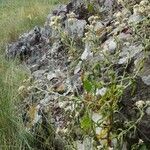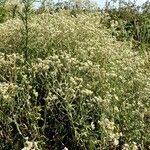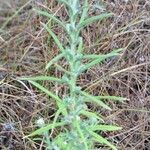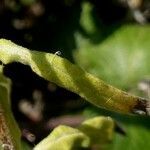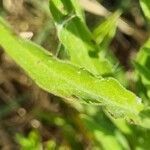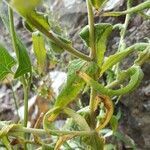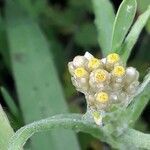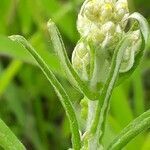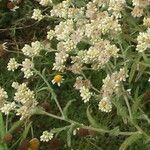Spreading, aromatic, grey-woolly, annual herb, up to 0.6 m high. Leaves alternate, sessile, oblong-lanceolate or lanceolate, upper ones linear-lanceolate, apex acute to acuminate, base cordate, main cauline leaves decurrent, wings often reaching the node below, margins entire, upper surface glandular, lower surface white-felted, discolorous. Capitula disciform, several together in dense clusters, these arranged in a large, corymbose panicle; involucral bracts whitish. Outer florets female, filiform, more than disc florets, yellowish. Disc florets tubular, yellowish. Flowering time Aug.-May. Pappus of barbellate bristles. Cypselae oblong, glabrous.
Annual herb, up to 0.6 m high, erect. Leaves alternate, sessile; blade very narrowly ovate to linear, apex acute to acuminate, bases of main stem leaves decurrent, wings often reaching node below, bases of upper leaves cordate; upper surface glandular, green, drying brown, lower surface white-felted, discolorous. Heads disciform, with up to 100 flowers, several in tight clusters, arranged in corymbose panicles. Involucral bracts ± 4-seriate, whitish, woolly at base, stereome divided. Flowers: outer female florets many, filiform; disc florets few; yellowish; Dec.-Apr. Fruit with cypsela ellipsoid, glabrous. Pappus of many barbellate bristles.
Much-branched, aromatic, grey-woolly annual, up to 0.5 m tall. Leaves narrowly lanceolate, apex acute, clasping at base and running down stem, often reaching lower node, discolorous, glabrescent and glandular above, white-woolly below. Flowerheads disciform, in dense corymbs; involucral bracts whitish; disc florets yellowish. Cypselas glabrous; pappus of barbellate bristles.
Much-branched, aromatic, grey-woolly annual to 50 cm. Leaves narrowly lanceolate-acute, clasping at base, broadly decurrent, discolorous, glabrescent and glandular above, white felted beneath. Flower heads disciform, in dense corymbs, whitish.
Annual herb, up to 0.6 m high. Main stem leaves decurrent, wings often reaching the node below. Leaves oblong-lanceolate or lanceolate, apex acute to acuminate, discolorous. Flowers yellowish.
